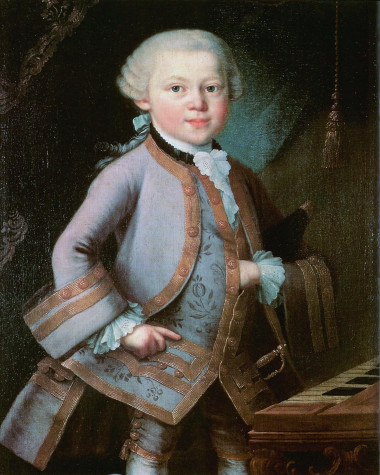Young Mozart and the five tests
'An account of a very remarkable young musician', says the table of contents of a six hundred page book published in 1781. The english edition of Miscellanies, among studies on various topics such as the periodical appearance and disappearance of certain birds, the possibilities of accessing the arctic, as well as ancient tragedies, also contains one of the most important documents on Mozart's wunderkind years.
The author of the abovementioned report, Daines Barrington, was an English lawyer, an antique collector and a naturalist. He met young Mozart in June 1765 during a European tour of the Mozart family. The scientist visited the family at their London accommodations to personally confirm Wolfgang’s famed musical abilities. His account was originally published by the Royal Society magazine called Philosophical Transactions, and then included in the essay collection of the author, with a brief introduction of four English prodigies.
Today, when music students and musicians learn to interpret musical compositions from sheet music, Barrington’s way of measuring musical ability can be surprising. Not only in the case of young Mozart, but also the four other children studied by the author, reading scores and improvisation both played an important role in the tests (or ex tempore play, as they called it). In many cases, there was no sharp division between composers and masters of instrumental play; in fact, it was expected from keyboard players to be able to independently elaborate at least one harmony sequence. In the romantic tradition, fantasy was an integral part of public concerts; just think of Liszt and his students. The 18-19th century keyboard disciplines (the best known among them the works of Carl Philipp Emanuel Bach, Daniel Gottlob Türk and Carl Czerny) devoted entire chapters to the tricks of improvisation, and listed natural skills, basic harmonics knowledge and instrumental virtuosity as necessary prerequisites.

Young Mozart could improvise even
with the keys of the harpsichord covered.
As a first test, Barrington gave a recent duet to young Wolfgang, one he had never seen before. The child not only sang his own part, but also played accompaniment on the harpsichord, and corrected his father if he made a mistake in the other part. As he started the piece, he immediately hit the right pace and style, which was, as Barrington noted, remarkable even for great masters.
Then Wolfgang had to improvise a love aria and a rage aria. (During the latter, the author described him as becoming so excited that he rose up in his chair and beat his keys obsessively.) As Barrington observed, the size and form of the pieces corresponded to what was common on the opera stages, and witnessed a rich invocation.
Eventually, Wolfgang completed three minor tasks: demonstrating excellent technical skills, he played his own finished étude, wrote a bass part for a given melody (i.e. harmonized it) and continued playing even after the keys of the harpsichord had been covered.
Without exceptional skills and natural talent, he would not have been able to pass the tests, but it’s only fair to mention that they used to play almost exclusively contemporary works at that time, which surely made his job easier. He had heard quite a lot of pieces and was musical enough to understand the musical language of the era, making him capable of imagining the character of a part based on the score, or summon the musical figures associated with a given text and dramatic situation in operas. Barrington himself, who did not hide his admiration otherwise, did not claim more than that: in fact, he said that the two arias were not particularly prominent, just slightly better than mediocre. He could not predict the future...
However, Barrington’s report reveals one important detail. The wunderkind Mozart had to use his musical imagination at least as intensely as his fingers. And he would do so at other times when, for example in Vienna and Italy, he was put to similar tests.
Fanni Molnár


